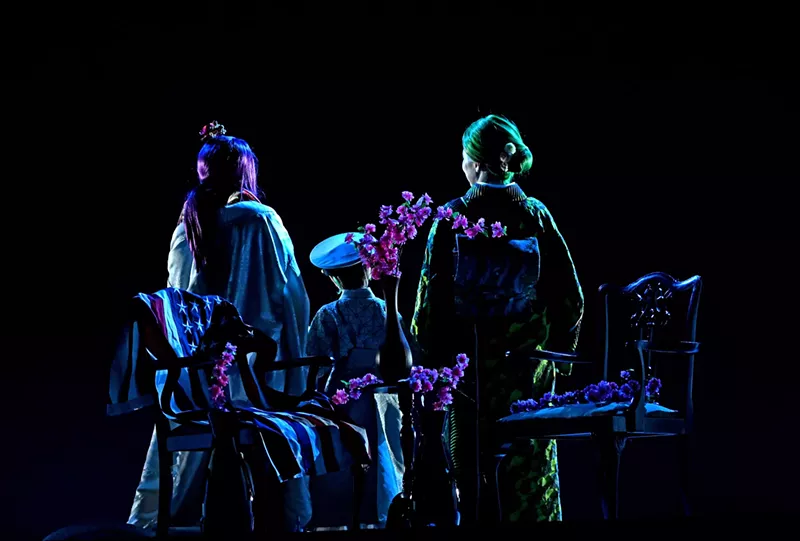
Philip Groshong, Cincinnati Opera
This production of Madame Butterfly turns it into a virtual reality fantasy.
Call for Puccini’s 1904 opera Madame Papillon problematic would be an understatement.
The popular Italian opera is set in Japan when a 15-year-old Japanese girl, Cio-Cio-San (aka Madame Butterfly), falls in love with an American naval officer stationed in Nagasaki named BF Pinkerton. The two are married and have a son but Pinkerton returns to the United States. When he returns to Japan with his new American wife, he intends to adopt the child and raise him at home without Butterly. Butterfly ultimately commits suicide.
Not only is the opera offensive in its depiction of Japanese women as exotic and submissive, but it also fetishizes Japanese culture and reinforces stereotypes. Some productions have even included white actors in “Yellowface.” But not this time. When Madame Papillon comes to the Detroit Opera House in October, it will be led by an all-Japanese and Japanese-American creative team.
Directed by Matthew Ozawa with Dots collective scenography, this production of Madame Butterfly reinvents tragic opera while bringing the fetishized white male gaze of the original production to full throttle. In this version, the play is presented as Pinkerton’s fantasy in a virtual reality setting.
Kimie Nishikawa, one of the dots members, says Metro timetable the creative team decided to play on operatic stereotypes to satirize the original material.
“Instead of twisting the story to seem like we were empowering one of the characters, we actually zoomed out a little bit more, saying it had nothing to do with Japan “, she says. “It was all these white European men fantasizing about this 14-year-old Japanese girl, so we’re like, wait a minute. That’s the concept, that it’s not real. That it’s all just a fantasy.
The set and lighting are also designed to look like a video game.
“Some East Asians might be surprised: Why are they doing this? Why do they accentuate stereotypes of East Asian culture? But really what we’re trying to do is reinforce how absurd the libretto is,” says Nishikawa. “A lot of operas focused more on the beauty of the music, which is really beautiful, but when you look at the libretto, it’s really horrible.”
In one scene, Pinkerton tries to determine Choi-Choi-San’s age and guesses that she is 10 or 18, before realizing that she is actually 14. This leads to a song about 14 years old as being the age of toys and candy, which transforms Pinkerton. as Nishikawa explains.
“I do not think so Madame Papillon in its original way should be interpreted,” she says. “Wherever a company wants to do it, I think they have to do the work, challenge it and really try to update it in their own way. But I don’t necessarily agree with banning this opera either.”
Nishikawa grew up in Japan and the United States. She lived in the United States between two and ten years, then returned to Japan. She says she found it difficult to empathize with the characters in Madame Papillon because it was clear that they were written from the perspective of a white man.
THE Madame Papillon The opera is based on a play by David Belasco adapted from a short story of the same name by John Luther Long. The story is said to be based on a second-hand account from Long’s sister whose husband was a Methodist missionary in Japan. Apparently neither Puccini, Belasco nor Puccini had ever been to Japan before writing.
Kristen Choi, who plays Suzuki, Cio-Cio-San’s servant in the production, says that instead of Butterfly committing suicide at the end, she “kills the white man’s fantasy about Asian women.”
“I want the show to make a statement for our community, especially in the opera industry,” she says. “We need to kill this narrative so we can open the door to more real stories about the Asian community… If this is what people think Asian culture is and we don’t get other stories told, They never will be.” I truly know the true identities of our community.
Choi has participated in at least 10 other productions of Madame Butterfly and says the opera itself is not offensive, but that directors often don’t do enough research about Japan to create an accurate portrait.
Nishikawa said Madame Papillon is extremely popular in Japan and Choi suspects it’s because it’s still performed and directed by Japanese people. This series of Madame Papillon This is the first time this has been made in the United States with an all-Japanese and Japanese-American creative team.
The Detroit Opera singers, chorus and musicians will be directed by Kensho Watanabe. Alongside Nishikawa, the team also includes two other Japanese/Japanese women, Maiko Matsushima for costume design and Yuki Nakase Link for lighting design.
Nishikawa was initially hesitant to get involved with opera, but says the team found a way to give Japanese women a voice with this new update.
“We’re really pointing out the white male gaze and how problematic that is,” she says. “Because we’re doing this, I feel like we’re seen, that we’ve been able to express a lot of our voices as Japanese women in the room…and, in the end, there’s a more focused light on Butterfly itself as the modern Orient. Asian woman.”
Madame Papillon is a co-production between Detroit Opera, Cincinnati Opera, Pittsburgh Opera and Utah Opera. There will be three performances in Detroit on October 7, 13 and 15.
For more information, see detroitopera.org.
Subscribe to Metro Times newsletters.
Follow us: Google News | News | Reddit | Instagram | Facebook | Twitter


